Makin Island Raid: Difference between revisions
Pbcjohnston (talk | contribs) mNo edit summary |
Pbcjohnston (talk | contribs) mNo edit summary |
||
| Line 8: | Line 8: | ||
The Marines encountered considerable difficulties in embarking on the rubber boats from the side of the rolling submarines. Boats were overturned and engines swamped. They eventually headed off to the beach, got reorganized, and attacked their objectives. Nautilus stood by in support, lobbing 65 rounds from her big 6-inch guns into the lagoon, striking a small freighter and a patrol craft, although later analysis could not confirm any sinkings. The return to the submarines after the raid was equally chaotic, requiring significant effort and risk by both the Marines and the submarine crews. In the end, 30 Marines were not accounted for and believed dead (in fact, nine were still alive and were captured; they were later executed). The submarines set sail for Hawaii, carefully tending to numerous wounded Marines. They arrived in Pearl Harbor to a hero's welcome. | The Marines encountered considerable difficulties in embarking on the rubber boats from the side of the rolling submarines. Boats were overturned and engines swamped. They eventually headed off to the beach, got reorganized, and attacked their objectives. Nautilus stood by in support, lobbing 65 rounds from her big 6-inch guns into the lagoon, striking a small freighter and a patrol craft, although later analysis could not confirm any sinkings. The return to the submarines after the raid was equally chaotic, requiring significant effort and risk by both the Marines and the submarine crews. In the end, 30 Marines were not accounted for and believed dead (in fact, nine were still alive and were captured; they were later executed). The submarines set sail for Hawaii, carefully tending to numerous wounded Marines. They arrived in Pearl Harbor to a hero's welcome. | ||
While over half of the Japanese garrison was killed by the Raiders and valuable experience in amphibious landings was obtained, the raid for the most part did not achieve its objectives. The Japanese did not take the bait and little if any enemy forces were diverted from the Solomons. | While over half of the Japanese garrison was killed by the Raiders and valuable experience in amphibious landings was obtained, the raid for the most part did not achieve its objectives. The Japanese did not take the bait and little if any enemy forces were diverted from the Solomons. Later, realizing their vulnerabilities in the Marshalls, the Japanese ''reinforced'' all of the island garrisons there, turning the later invasion of Tarawa into a bloodbath and a Marine legend. The final legacy of the raid is mixed, and historians have debated this point for decades. For further information, we encourage you to read the articles at the links below: | ||
●[https://text-message.blogs.archives.gov/2012/11/14/seventy-years-ago-the-makin-island-raid-august-1942-2/ Seventy Years Ago: The Makin Island Raid, August 1942]<br> | ●[https://text-message.blogs.archives.gov/2012/11/14/seventy-years-ago-the-makin-island-raid-august-1942-2/ Seventy Years Ago: The Makin Island Raid, August 1942]<br> | ||
| Line 67: | Line 67: | ||
[[File:Nautilus Makin Island 7.jpg|left|500px]] | [[File:Nautilus Makin Island 7.jpg|left|500px]] | ||
<div style="text-align: justify;"><span style="color:#00008B">LtCol. Evans Carlson, C.O. of the 2nd Marine Raider Battalion, standing in the same space as photographed above, looking the worse for | <div style="text-align: justify;"><span style="color:#00008B">LtCol. Evans Carlson, C.O. of the 2nd Marine Raider Battalion, standing in the same space as photographed above, looking the worse for wear, still dressed in his assault uniform. Carlson was an experienced and capable officer, having seen combat in WWI and Nicaragua, and held the exalted status of a China Marine of the old 4th Marine Regiment. He was charismatic with a forceful personality, and held the ear of the Roosevelts. Indeed, Captain James Roosevelt, the President's son, was one of his officers during this raid. Carlson went on to distinguished service on Guadalcanal. | ||
<small>U.S. Navy photo</small> | <small>U.S. Navy photo</small> | ||
| Line 76: | Line 76: | ||
<div style="text-align: justify;"><span style="color:#00008B">The Argonaut approaching the dock at Submarine Base Pearl Harbor after she and Nautilus returned from the Makin Island raid with "Carlson's Raiders". | <div style="text-align: justify;"><span style="color:#00008B">The Argonaut approaching the dock at Submarine Base Pearl Harbor after she and Nautilus returned from the Makin Island raid with "Carlson's Raiders". | ||
Between the end of the dock and the bow of Argonaut you can see the bow of the Nautilus, headed to the opposite side of the pier. A Marine honor guard is on the pier along with a Navy Band and the Commander-in-Chief | Between the end of the dock and the bow of Argonaut you can see the bow of the Nautilus, headed to the opposite side of the pier. A Marine honor guard is on the pier along with a Navy Band and the Commander-in-Chief of the Pacific Fleet, Admiral Chester W. Nimitz, USN. | ||
<small>National Archives photo</small> | <small>National Archives photo</small> | ||
| Line 90: | Line 90: | ||
[[File:Nautilus Makin Island 11.jpg|left|500px]] | [[File:Nautilus Makin Island 11.jpg|left|500px]] | ||
<div style="text-align: justify;"><span style="color:#00008B">Nautilus (left) and Argonaut (right) moored at Submarine Base Pearl Harbor, August 26, 1942 at the conclusion of the Makin Island raid. Their arrival generated a lot of interest and the Navy/Marine Corps | <div style="text-align: justify;"><span style="color:#00008B">Nautilus (left) and Argonaut (right) moored at Submarine Base Pearl Harbor, August 26, 1942 at the conclusion of the Makin Island raid. Their arrival generated a lot of interest and the Navy/Marine Corps took full advantage of the boost in morale the raid gave to the nation. | ||
<small>Photo courtesy of Robert Hurst via Navsource.org</small> | <small>Photo courtesy of Robert Hurst via Navsource.org</small> | ||
| Line 97: | Line 97: | ||
[[File:Nautilus Makin Island 10.jpg|left|500px]] | [[File:Nautilus Makin Island 10.jpg|left|500px]] | ||
<div style="text-align: justify;"><span style="color:#00008B">Crew and Marines muster on deck as the "Brass" show up to welcome everyone home. Admiral Chester Nimitz, Commander-in-Chief Pacific Fleet (CINCPACFLT) stands in the center amid a group of probably squadron and division commanders and aides. On the left wearing the garrison cap is LtCol Carlson. Next to the right is most likely Submarine Squadron Four C.O., Commander John H. "Babe" Brown, Jr. Nautilus was assigned to SubRon 4. The Marine wearing the helmet with his back to the camera is not known, but it is possible that he is Captain James | <div style="text-align: justify;"><span style="color:#00008B">Crew and Marines muster on deck as the "Brass" show up to welcome everyone home. Admiral Chester Nimitz, Commander-in-Chief Pacific Fleet (CINCPACFLT) stands in the center amid a group of probably squadron and division commanders and aides. On the left wearing the garrison cap is LtCol Carlson. Next to the right is most likely Submarine Squadron Four C.O., Commander John H. "Babe" Brown, Jr. Nautilus was assigned to SubRon 4. The Marine wearing the helmet with his back to the camera is not known, but it is possible that he is Captain James Roosevelt. The officer facing Nimitz with the sunglasses in unknown. On the far right the officer looking at the camera is Rear Admiral Robert H. English, Commander Submarine Force Pacific Fleet (COMSUBPAC). | ||
<small>U.S. Navy photo</small> | <small>U.S. Navy photo</small> | ||
| Line 104: | Line 104: | ||
[[File:Nautilus Makin Island 9.jpg|left|500px]] | [[File:Nautilus Makin Island 9.jpg|left|500px]] | ||
<div style="text-align: justify;"><span style="color:#00008B">A mixture of Navy and Marines pose for a photo | <div style="text-align: justify;"><span style="color:#00008B">A mixture of Navy and Marines pose for a photo on the Nautilus after the raid on Makin Island. Being stuck in the small vessel together probably resulted in some good friendships. | ||
Middle row all the way to the right is one of the two Filipino | Middle row all the way to the right is one of the two Filipino Stewards Mates. There was also an African American Mess Attendant assigned to the submarine. | ||
<small>U.S. Navy photo</small> | <small>U.S. Navy photo</small> | ||
| Line 120: | Line 120: | ||
[[File:Argonaut makin-3.jpg|left|500px]] | [[File:Argonaut makin-3.jpg|left|500px]] | ||
<div style="text-align: justify;"><span style="color:#00008B">A Marine Raider, injured during the Makin operation, is lifted through a hatch on the Argonaut to be taken ashore at Pearl Harbor, 26 August 1942. Though the crew are being as careful as they can the man is in obvious pain from his injuries. Submarine hatches are not made for easy removal of the injured. It is interesting to note that a civilian is assisting with the Marine's removal. Perhaps he is a civilian doctor, as military doctors may have been in short supply at that point in the war. It is also possible that he was a newspaper | <div style="text-align: justify;"><span style="color:#00008B">A Marine Raider, injured during the Makin operation, is lifted through a hatch on the Argonaut to be taken ashore at Pearl Harbor, 26 August 1942. Though the crew are being as careful as they can the man is in obvious pain from his injuries. Submarine hatches are not made for easy removal of the injured. It is interesting to note that a civilian is assisting with the Marine's removal. Perhaps he is a civilian doctor, as military doctors may have been in short supply at that point in the war. It is also possible that he was a newspaper reporter who was covering the event and he pitched in to help. | ||
<small>National Archives photo</small> | <small>National Archives photo</small> | ||
| Line 127: | Line 127: | ||
[[File:Nautilus Makin Island 8.jpg|left|500px]] | [[File:Nautilus Makin Island 8.jpg|left|500px]] | ||
<div style="text-align: justify;"><span style="color:#00008B">A Nautilus crewman paints a rising sun and a hash mark on one of the two 6 | <div style="text-align: justify;"><span style="color:#00008B">A Nautilus crewman paints a rising sun and a hash mark on one of the two 6"/53 caliber deck guns representing the vessels believed to be sunk at Makin Island with her guns. At least one small freighter and a patrol boat were hit in the action by Nautilus' gunnery, but later analysis could not confirm that either sank. | ||
<small>U.S. Navy photo</small> | <small>U.S. Navy photo</small> | ||
Revision as of 13:55, 16 October 2023
Notes
Companies A and B of the 2nd Marine Raider Battalion were chosen for the raid, a total of 211 men. They were led by the charismatic LtCol Evans F. Carlson, a WWI, Nicaragua, and China veteran. One of Carlson's officers was Captain James Roosevelt, son of the President. Secrecy was important, so the plan had the Raiders transported to Makin on two of the huge old V-boats, Nautilus (SS-168) and Argonaut (SM-1). After a short period of periscope beach reconnaissance, the Marines were to be landed via outboard engine powered rubber inflatable boats. Once ashore they were to engage and kill as many of the Japanese garrison troops as possible, take prisoners if feasible, gather intelligence, and destroy any military facilities. The submarines got underway from Pearl Harbor on August 8, 1942 (the day after the Guadalcanal landings) and arrived off Makin on August 16. The assault was planned for the next morning.
The Marines encountered considerable difficulties in embarking on the rubber boats from the side of the rolling submarines. Boats were overturned and engines swamped. They eventually headed off to the beach, got reorganized, and attacked their objectives. Nautilus stood by in support, lobbing 65 rounds from her big 6-inch guns into the lagoon, striking a small freighter and a patrol craft, although later analysis could not confirm any sinkings. The return to the submarines after the raid was equally chaotic, requiring significant effort and risk by both the Marines and the submarine crews. In the end, 30 Marines were not accounted for and believed dead (in fact, nine were still alive and were captured; they were later executed). The submarines set sail for Hawaii, carefully tending to numerous wounded Marines. They arrived in Pearl Harbor to a hero's welcome.
While over half of the Japanese garrison was killed by the Raiders and valuable experience in amphibious landings was obtained, the raid for the most part did not achieve its objectives. The Japanese did not take the bait and little if any enemy forces were diverted from the Solomons. Later, realizing their vulnerabilities in the Marshalls, the Japanese reinforced all of the island garrisons there, turning the later invasion of Tarawa into a bloodbath and a Marine legend. The final legacy of the raid is mixed, and historians have debated this point for decades. For further information, we encourage you to read the articles at the links below:
●Seventy Years Ago: The Makin Island Raid, August 1942
●The Makin Island Raid: What Really Happened to the Marines?
●The Makin Island Raid

U.S. Navy photo
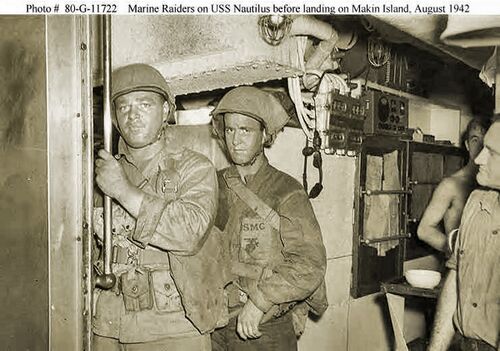
U.S. Navy photo
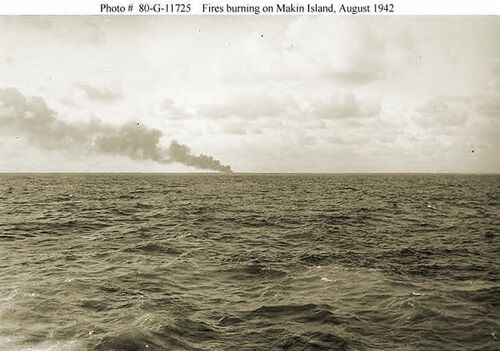
At 0703 AM she provided gunfire support against enemy positions on Ukiangong Point and then shelled the enemy ships in the lagoon. At 1039, an enemy plane appeared and Nautilus dove. Two aerial attacks followed at 1130 and another at 1255 keeping her down.
U.S. Navy photo
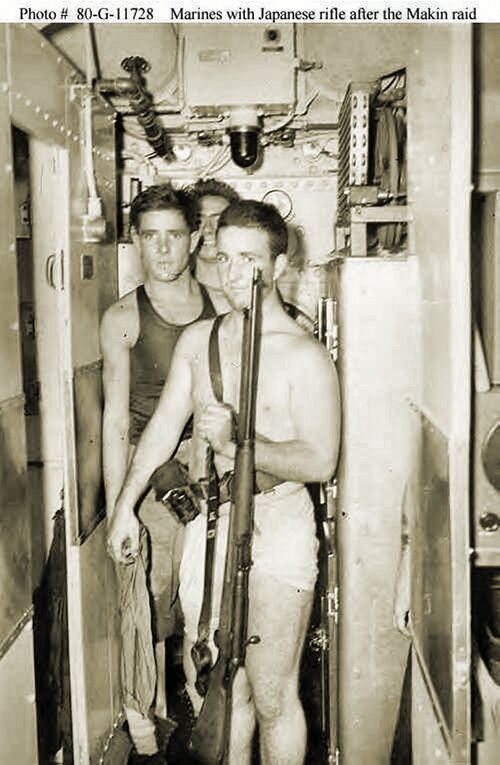
Interior photos of Nautilus are very rare. Despite its size it was still tight quarters, especially with 200+ Marines aboard.
U.S. Navy photo

After the raid Japanese records say that of the 71 Japanese on the island only 27 were alive when reinforcements arrived.
U.S. Navy photo
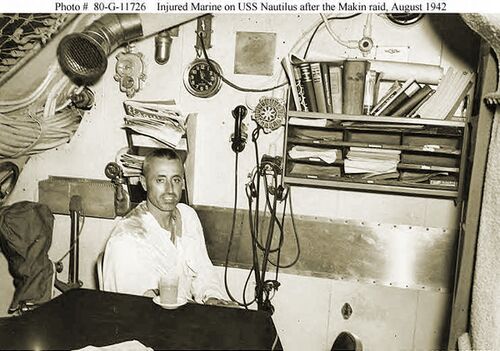
U.S. Navy photo
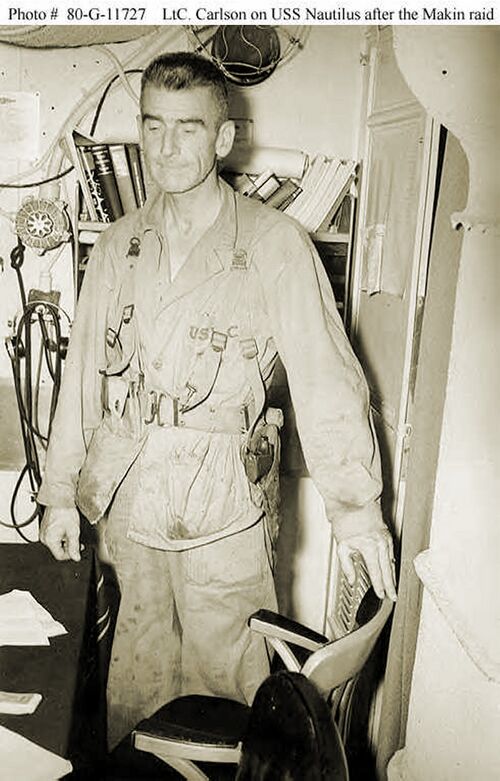
U.S. Navy photo
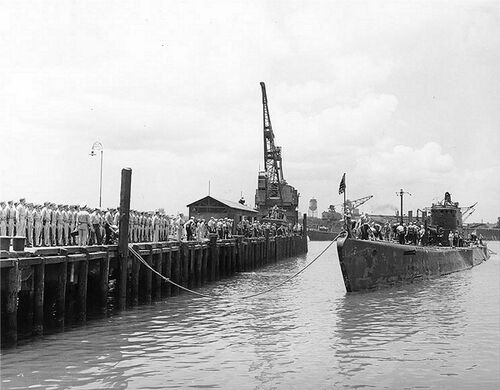
Between the end of the dock and the bow of Argonaut you can see the bow of the Nautilus, headed to the opposite side of the pier. A Marine honor guard is on the pier along with a Navy Band and the Commander-in-Chief of the Pacific Fleet, Admiral Chester W. Nimitz, USN.
National Archives photo
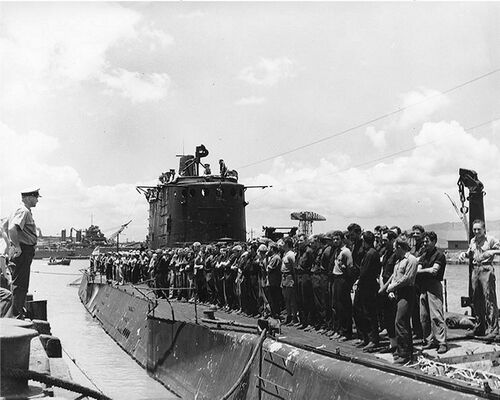
National Archives photo
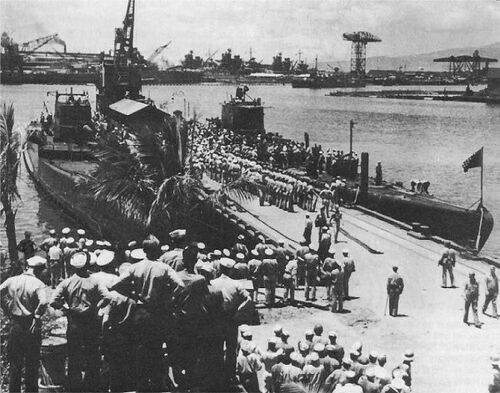
Photo courtesy of Robert Hurst via Navsource.org

U.S. Navy photo
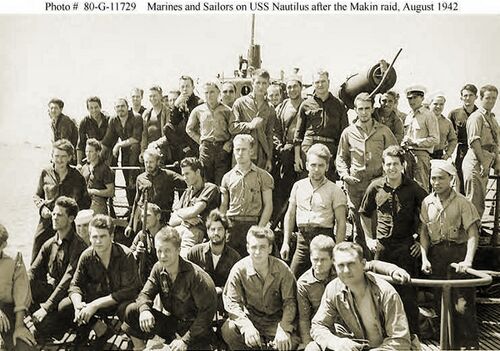
Middle row all the way to the right is one of the two Filipino Stewards Mates. There was also an African American Mess Attendant assigned to the submarine.
U.S. Navy photo
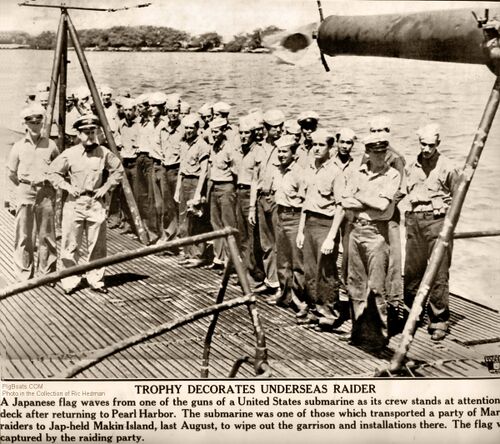
Photo in the private collection of Ric Hedman

National Archives photo

U.S. Navy photo
Page created by:
Ric Hedman & David Johnston
1999 - 2023 - PigBoats.COM©
Mountlake Terrace, WA, Norfolk, VA
webmaster at pigboats dot com
